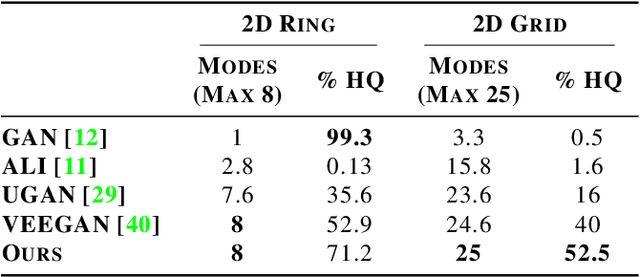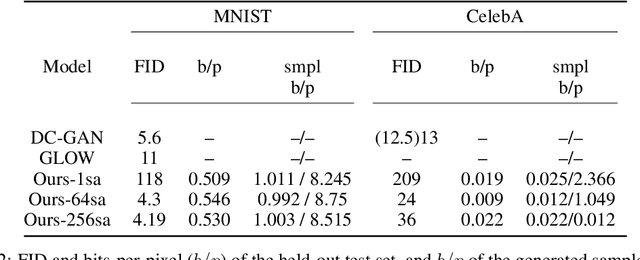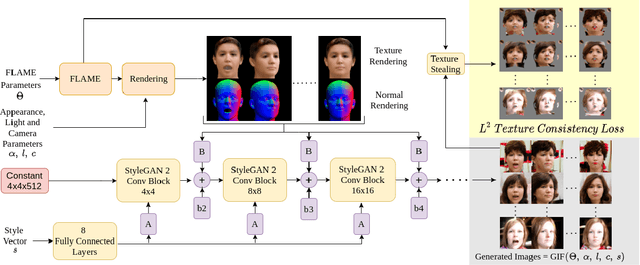Pravir Singh Gupta
Adversarial Likelihood Estimation with One-way Flows
Jul 19, 2023



Abstract:Generative Adversarial Networks (GANs) can produce high-quality samples, but do not provide an estimate of the probability density around the samples. However, it has been noted that maximizing the log-likelihood within an energy-based setting can lead to an adversarial framework where the discriminator provides unnormalized density (often called energy). We further develop this perspective, incorporate importance sampling, and show that 1) Wasserstein GAN performs a biased estimate of the partition function, and we propose instead to use an unbiased estimator; 2) when optimizing for likelihood, one must maximize generator entropy. This is hypothesized to provide a better mode coverage. Different from previous works, we explicitly compute the density of the generated samples. This is the key enabler to designing an unbiased estimator of the partition function and computation of the generator entropy term. The generator density is obtained via a new type of flow network, called one-way flow network, that is less constrained in terms of architecture, as it does not require to have a tractable inverse function. Our experimental results show that we converge faster, produce comparable sample quality to GANs with similar architecture, successfully avoid over-fitting to commonly used datasets and produce smooth low-dimensional latent representations of the training data.
LED: Latent Variable-based Estimation of Density
Jun 23, 2022



Abstract:Modern generative models are roughly divided into two main categories: (1) models that can produce high-quality random samples, but cannot estimate the exact density of new data points and (2) those that provide exact density estimation, at the expense of sample quality and compactness of the latent space. In this work we propose LED, a new generative model closely related to GANs, that allows not only efficient sampling but also efficient density estimation. By maximizing log-likelihood on the output of the discriminator, we arrive at an alternative adversarial optimization objective that encourages generated data diversity. This formulation provides insights into the relationships between several popular generative models. Additionally, we construct a flow-based generator that can compute exact probabilities for generated samples, while allowing low-dimensional latent variables as input. Our experimental results, on various datasets, show that our density estimator produces accurate estimates, while retaining good quality in the generated samples.
GIF: Generative Interpretable Faces
Aug 31, 2020



Abstract:Photo-realistic visualization and animation of expressive human faces have been a long standing challenge. On one end of the spectrum, 3D face modeling methods provide parametric control but tend to generate unrealistic images, while on the other end, generative 2D models like GANs (Generative Adversarial Networks) output photo-realistic face images, but lack explicit control. Recent methods gain partial control, either by attempting to disentangle different factors in an unsupervised manner, or by adding control post hoc to a pre-trained model. Trained GANs without pre-defined control, however, may entangle factors that are hard to undo later. To guarantee some disentanglement that provides us with desired kinds of control, we train our generative model conditioned on pre-defined control parameters. Specifically, we condition StyleGAN2 on FLAME, a generative 3D face model. However, we found out that a naive conditioning on FLAME parameters yields rather unsatisfactory results. Instead we render out geometry and photo-metric details of the FLAME mesh and use these for conditioning instead. This gives us a generative 2D face model named GIF (Generative Interpretable Faces) that shares FLAME's parametric control. Given FLAME parameters for shape, pose, and expressions, parameters for appearance and lighting, and an additional style vector, GIF outputs photo-realistic face images. To evaluate how well GIF follows its conditioning and the impact of different design choices, we perform a perceptual study. The code and trained model are publicly available for research purposes at https://github.com/ParthaEth/GIF.
LISR: Image Super-resolution under Hardware Constraints
Sep 23, 2019



Abstract:We investigate the image super-resolution problem by considering the power savings and performance improvement in image acquisition devices. Toward this end, we develop a deep learning based reconstruction network for images compressed using hardware-based downsampling, bit truncation and JPEG compression, which to our best knowledge, is the first work proposed in the literature. This is motivated by the fact that binning and bit truncation can be performed on the commercially available image sensor itself and results in a huge reduction in raw data generated by the sensor. The combination of these steps will lead to high compression ratios and significant power saving with further advantages of image acquisition simplification. Bearing these concerns in mind, we propose LISR-net (Lossy Image Super-Resolution network) which provides better image restoration results than state-of-the-art super resolution networks under hardware constraints.
 Add to Chrome
Add to Chrome Add to Firefox
Add to Firefox Add to Edge
Add to Edge